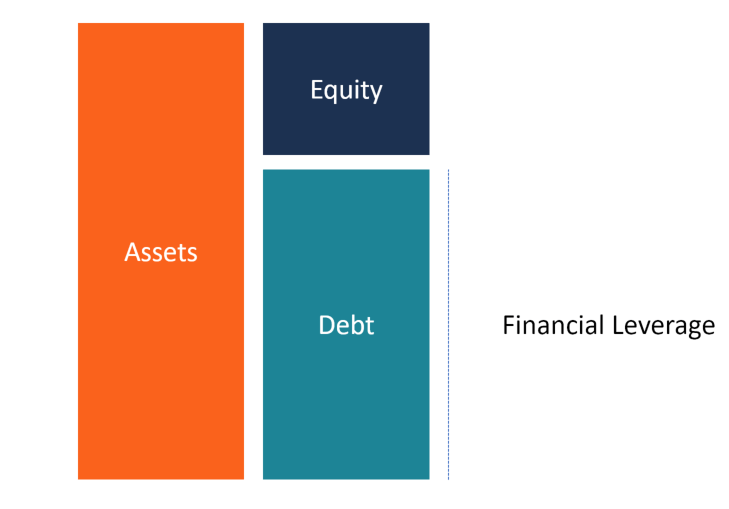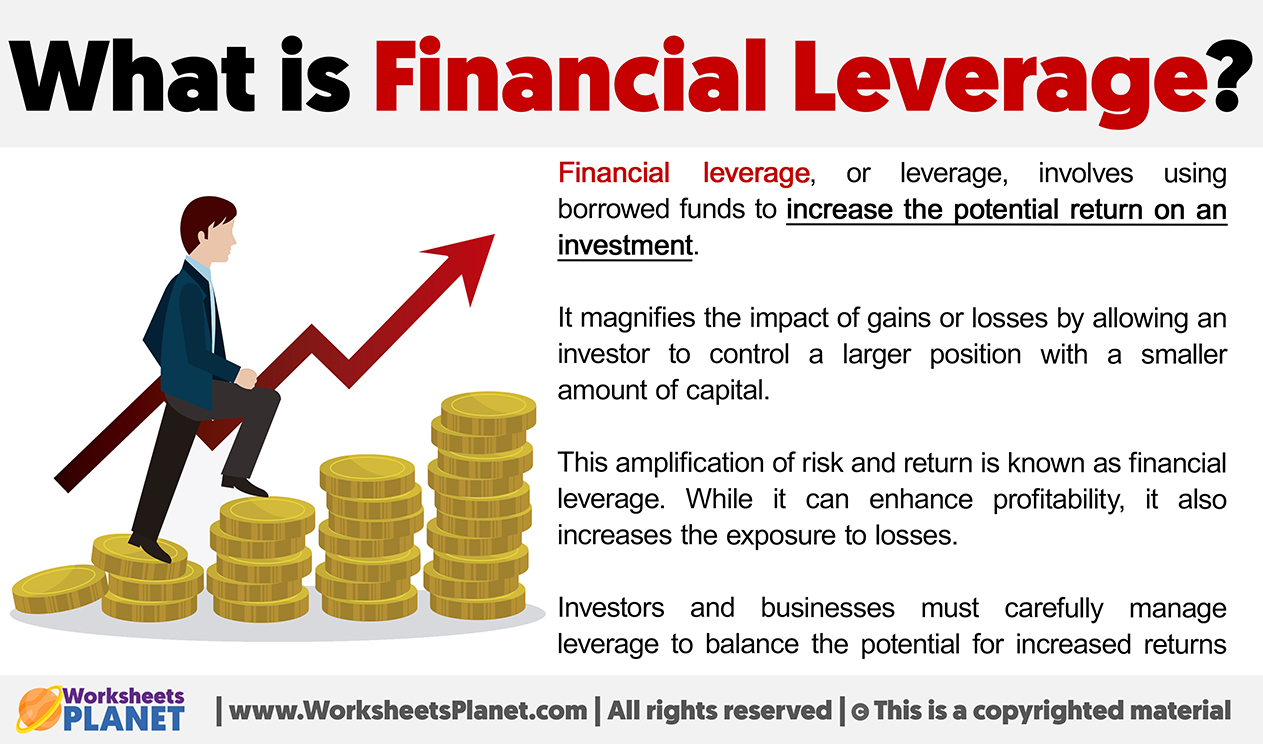Have you ever heard someone say, “They used leverage to grow fast” and wondered what that means? You’re not alone! So, what is financial leverage? It’s when a business uses borrowed money (debt) to boost its return on investment.
In simple words, financial leverage helps businesses do more with less. But like any tool, it needs to be used wisely.
Understanding leverage is important because it shows how companies grow faster, take risks, and sometimes fall hard.

What is Financial Leverage?
Financial leverage means using borrowed money. This is done to increase the return on investment. It involves taking a loan or debt. The borrowed money is then used to invest. If the investment does well, the returns are higher.
Credit: corporatefinanceinstitute.com
How Does Financial Leverage Work?
Financial leverage works in a simple way. Here is how it works:
- First, you borrow money.
- Second, you invest the borrowed money.
- If the investment does well, you earn more money.
- You then pay back the loan with interest.
- The extra money you earn is your profit.

Benefits of Financial Leverage
There are several benefits of financial leverage:
- It can increase your returns.
- You can invest in bigger projects.
- You can grow your business faster.
Increase Returns
Imagine you’re opening a tea stall. You have $500 but need $1,000 for a great location and setup. So, you borrow $500. If your stall earns $200 in profit, your return is higher than if you’d used just your own money. That’s leverage in finance!
It’s all about using debt financing to grow. This strategy can amplify gains but also risks. Businesses often use it to expand quickly, but they must be cautious not to misuse it.

Bigger Projects
Financial leverage allows you to invest in bigger projects. Bigger projects can have higher returns. This is because they often have more growth potential.
Business Growth
Businesses can grow faster with financial leverage. They can invest in new equipment. They can also expand to new markets. This can increase their revenue and profits.
Risks of Financial Leverage
Financial leverage has risks. It is important to understand these risks. Here are some risks:
- You must pay back the loan with interest.
- If the investment fails, you can lose money.
- High debt levels can be dangerous.
Paying Back The Loan
You must pay back the loan. This includes interest. If you cannot pay it back, you can face trouble. This can lead to financial problems.
Investment Failure
If the investment fails, you still owe the loan. This means you lose money. You can end up in debt. It is a big risk.
High Debt Levels
Having too much debt is dangerous. It can hurt your credit score. It can also make it hard to get more loans. It is important to manage debt carefully.

How Leverage Works in Real Life
Think of a high-leverage company like a fast-growing startup that takes a loan to build new tech. It doesn’t have enough cash but has a big dream. It uses debt financing to scale faster.
Equity financing means selling ownership (shares), while debt financing is borrowing money to pay back later. Many companies prefer debt to avoid giving up control.
In the real world, both strategies have pros and cons. The trick is to balance them well.
Example 1: Real Estate Investment
Imagine you want to buy a house. The house costs $100,000. You have $20,000. You borrow $80,000. You rent out the house. The rent covers the loan payments and gives you extra money. This is financial leverage.
Example 2: Stock Market Investment
You want to buy stocks. You have $5,000. You borrow $15,000. You invest $20,000 in stocks. The stocks go up in value. You sell them for $25,000. You pay back the loan with interest. You still have a profit.

Credit: www.worksheetsplanet.com
The Core Ratios of Financial Leverage
Financial leverage is measured using ratios like the debt-to-equity ratio, leverage ratio, and gearing ratio.
Here are the three key ones:
- Leverage Ratio: Total Debt / Total Assets. Shows how much of your assets are financed by debt.
- Debt-to-Equity Ratio: Total Debt / Shareholder’s Equity. The higher the number, the more borrowed money is used.
- Gearing Ratio: Debt / (Debt + Equity). It tells how “geared” or dependent you are on debt.
Simple numbers, but they reveal a lot about risk.
Types of Financial Leverage
The two main types of leverage are operating leverage and financial leverage, and both affect a company’s performance differently.
- Operating Leverage: Uses fixed costs to magnify business profits. High operating leverage means more risk but more reward when sales go up.
- Financial Leverage: Focuses on using debt to increase investment returns.
Businesses often use both. Think of them like two spices in a dish – balance them right and you get a tasty profit.

Benefits of Financial Leverage
Financial leverage can help businesses grow faster, increase return on equity, and expand with limited capital.
- You can grow your business even if your funds are limited.
- Boosts your Return on Equity (ROE) since borrowed money can multiply earnings.
- Helps you take on bigger projects and compete with larger firms.
When used wisely, leverage becomes a superpower.
Risks and Drawbacks
- Financial risk goes up. If profits drop, debt doesn’t disappear.
- Disadvantages of financial leverage include interest costs, risk of bankruptcy, and reduced flexibility.
- Too much leverage can lead to trouble, especially if markets turn.
Think of it like driving fast – thrilling but dangerous if you’re not careful.
Financial Leverage in Business Strategy
Smart companies plan it out:
- When should we borrow?
- How much debt is too much?
- Will this help or hurt our cost of capital?
Leverage strategy is all about balance. A well-planned capital structure keeps a company stable, flexible, and profitable.

How to Analyze Leverage?
Leverage is analyzed through financial ratios and tools to understand risk, returns, and overall stability.
- Use the ratios we mentioned earlier.
- Watch for high leverage with low profits – a big red flag.
- Track trends over time, not just single reports.
Financial leverage analysis helps investors and managers make smarter choices.
FAQs
Why do companies use financial leverage?
To grow faster and take on bigger opportunities without needing more investors.
Is Financial Leverage good or bad?
It can be both. It helps you grow but also increases risk.
Why Is Financial Leverage Important?
It’s important because it can amplify profits, allowing businesses to grow faster with borrowed funds.
What is a good Leverage ratio?
The risks include potential losses, as debts must be repaid regardless of investment performance.
What’s the difference between Financial and Operating leverage?
Financial leverage uses debt; operating leverage uses fixed costs. Both amplify results but in different ways.

Final Thoughts
Financial leverage can be a useful tool. It can increase your returns. It can help you invest in bigger projects. It can also help your business grow. But, it has risks. It is important to understand these risks. Use financial leverage wisely. This will help you achieve your financial goals.




Leave a Reply